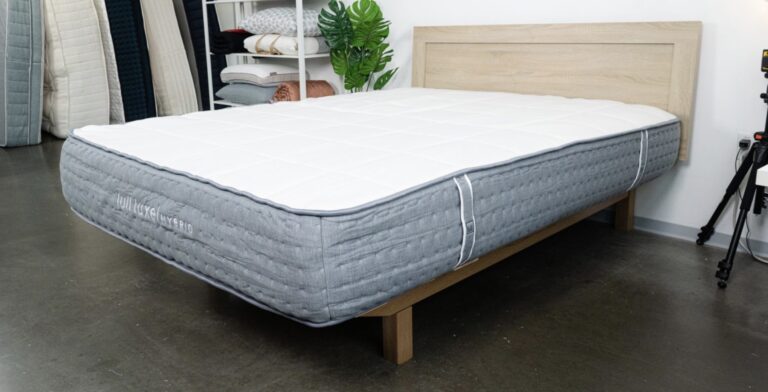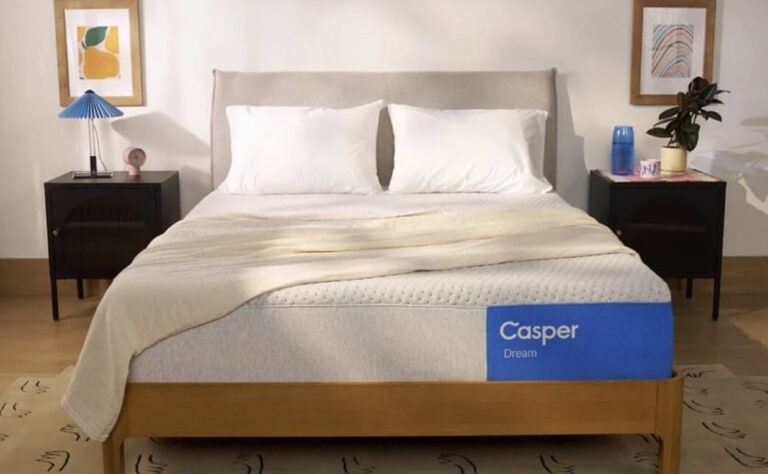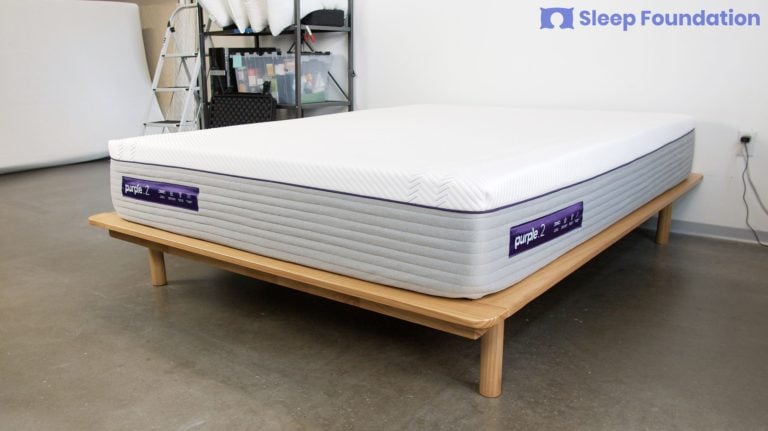When you buy through our links, we may earn a commission. Products or services may be offered by an affiliated entity. Learn more.
Leesa vs Tuft & Needle Mattress Comparison
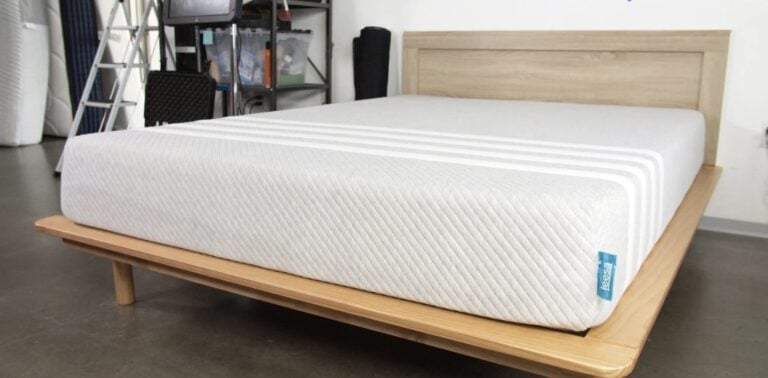
Leesa Original
Bottom Line
The Leesa Original is an all-foam mattress that excels at pressure relief and motion isolation with just the right amount of bounce.
20% off + 2 free pillows with mattress purchase
Full Mattress ReviewVS
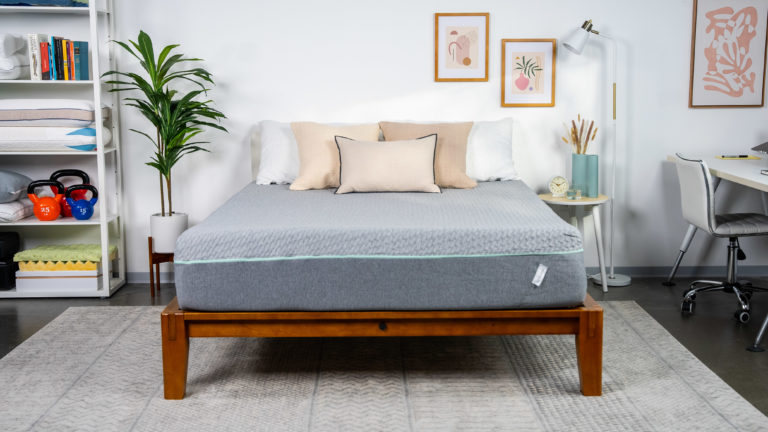
Tuft & Needle Original
Bottom Line
The budget-friendly Tuft & Original is built with breathable foams for a nice balance of cushioning, support, and breathability.
15% off mattresses
Full Mattress ReviewOnline shopping has brought huge changes to the mattress industry. Large numbers of customers have started buying online, and both Leesa and Tuft & Needle have helped lead the way in this major shift in how and where mattresses are purchased.
In addition to its flagship Original bed, Leesa now offers two hybrid mattresses – the Leesa Sapira Hybrid and a luxury model, the Leesa Legend – as well as another all-foam model, the Studio by Leesa.
Tuft & Needle has complemented its Original mattress with the Mint, a robust all-foam bed, and the Tuft & Needle Hybrid that utilizes a pocketed coil support core.
Comparing the Tuft & Needle and Leesa mattresses head-to-head creates an opportunity to identify the pros and cons of each. We look at all the key details — models, reviews, materials, ratings, returns, shipping, warranties, and more — to empower shoppers to make an informed pick between the Leesa and Tuft & Needle mattresses.
Quick Look
$639 – $2,079
$995 – $1,995
Medium (5), Medium Firm (6)
Medium (5), Medium Firm (6)
- Two foams, including memory foam, in comfort system
- Mixture of pressure relief and responsiveness
- Cover made with recycled plastics (Leesa Legend)
- Unique Adaptive Foam provides balance of contouring and bounce
- Quality temperature regulation for all-foam models
- Customer-friendly price point and sleep trial
- 100 nights (30 night requirement)
- 10 Year, Limited
- 100 nights
- 10-Year, Limited
- A+
- A+
Sizing Options
While you might have thought about the general contours of your bedroom and how a new mattress will fit, it’s worth taking the time to consider each component of mattress size as part of your research.
- Weight affects how easy it is to move, which takes on greater importance if you expect to rearrange furniture or relocate to a new home. Knowing the weight allows you to confirm that your frame can support any specific mattress.
- Height matters because it determines whether your fitted sheets will fit. You also want to consider the total height of your mattress on top of its frame and whether that will pose any difficulties getting in or out of bed. This is most often an issue for people with serious joint problems.
- Size of the mattress tells you its length and width. You want a mattress that gives you plenty of room to get comfortable but still leaves space in your bedroom to set up other furniture. Couples should get at least a Full mattress.
Leesa
Tuft & Needle
Height
10″Size Options
Twin, Twin XL, Full, Queen, King, California KingHeight
9.5?Size Options
Twin, Twin XL, Full, Queen, King, California KingHeight
11″Size Options
Twin, Twin XL, Full, Queen, King, California KingHeight
12″Size Options
Twin, Twin XL, Full, Queen, King, California KingHeight
12″Size Options
Twin XL, Full, Queen, King, California KingHeight
12″Size Options
Twin, Twin XL, Full, Queen, King, California KingStudio by Leesa
Height
10″Size Options
Twin, Twin XL, Full, Queen, King, California KingThe Leesa and Tuft & Needle mattresses are comparable in their dimensions.
- In terms of weight, hybrid models from both brands weigh considerably more than the foam options.
- All of the mattresses offered by Tuft & Needle and Leesa are between 10 and 12 inches tall. None are likely to pose problems with regular fitted sheets.
- Both companies use the standard mattress sizes — Twin, Twin XL, Full, Queen, King, and California King — and make all of their products available in these sizes. The only exception is the Leesa Legend that is offered in a Twin XL but not a Twin size.
While the dimensions are important to keep in mind anytime you’re looking for a new mattress, they do little to distinguish between the Leesa and Tuft & Needle products.
Construction and Materials Comparison
When you’re shopping for a car, it’s well-known that you need to take a good look under the hood. The same principle applies to mattresses. The way a mattress is built has huge implications for the way it feels. Durability is also shaped in large part by the interior components.
Under the cover, a mattress has two main parts: a comfort system and a support core. The comfort system is the top part and most often made with foam, latex, micro-coils, down, wool, polyester, and/or cotton. It can involve more than one layer and more than one material.
The support core is underneath the comfort system and keeps the mattress stable. A well-built support core can positively affect the feel, prevent excess sagging, and enable the comfort system to properly support the body.
The following sections review the construction of the Leesa and Tuft & Needle mattresses and what it means for shoppers.
Leesa
Leesa has two all-foam mattresses and two hybrid models. What distinguishes a hybrid is a support core that utilizes innerspring coils.
The use of a specialty polyfoam on top of memory foam is a consistent characteristic across all three of the Leesa mattress models. This creates a feel that captures many of the benefits of memory foam, such as spinal support and motion isolation, without succumbing to its downsides including excess sinking and a tendency to sleep hot.
Leesa Original
The all-foam offering is the Leesa Original. Its cover is a stretchy polyester blend. Underneath is a two-inch layer of polyfoam with a density of 3 pounds per cubic foot (PCF). The next layer is two inches of memory foam that also has a 3 PCF density. The support core is six inches of 1.8 PCF polyfoam.
The Leesa Original has a medium feel that is softer than the hybrid options. It provides more contouring and sink but retains enough responsiveness for most sleepers to keep from feeling stuck in the bed.
Leesa Sapira Hybrid
The Leesa Sapira Hybrid has a cotton blend for its cover, adding breathability and moisture-wicking. The comfort system has three layers: 1.5 inches of polyfoam (3 PCF), 1.5 inches of memory foam (4 PCF), and one inch of transition polyfoam (2 PCF). The support core is six inches of pocketed innerspring coils that are reinforced around the edge and one inch of polyfoam (1.8 PCF).
With the inclusion of a coil support core, the Leesa Sapira Hybrid has a firmer and bouncier feel than the Original. Its comfort system is thicker and is able to cushion pressure points and offer a notable step up in edge support.
Leesa Legend
The Leesa Legend is the company’s high-end model. Its cover is specially designed, utilizing polyester, recycled PES made from plastic bottles, organic cotton, merino wool, rayon, and spandex. Combined, the cover is stretchy, moisture-wicking, and helps combat plastic pollution.
The Legend’s comfort system has four layers: one inch of aerated, latex-like polyfoam, one inch of memory foam, 1.5 inches of zoned micro-coils, and one inch of transition polyfoam. The support core is made with six inches of pocketed coils that have a reinforced perimeter and rest on top of one inch of polyfoam.
By combining two layers of coils, the Leesa Legend doubles down on responsiveness, making it easy to move on top of the mattress, including during intimate activities. The zoned coils work with the foam layers to give tailored cushioning to the body’s pressure points.
Studio by Leesa
The Studio by Leesa is the company’s newest and most affordable mattress. An all-foam model, the Studio is very comparable to the Leesa Original. The comfort layer is composed of memory foam (2.5 PCF), while the transitional and support layers are high-density polyfoam. The Studio has a medium firm (6) feel, and is best suited to side and back sleepers who weigh 230 pounds or less.
Tuft & Needle
Tuft & Needle’s product line has two all-foam mattresses and one hybrid.
Components in All Tuft & Needle Mattresses
Mattress Cover
A common aspect of all three Tuft & Needle mattresses is their cover. In each case, the mattress has a cover made with a blend of polyester and micro-polyamide that is breathable, soft, and stretchy.
Adaptive Foam
Another component found in all three mattresses is Tuft & Needle’s Adaptive Foam. This material, a type of polyfoam, was developed by the company to have characteristics of both latex and memory foam.
Adaptive Foam has modest contouring; it doesn’t envelop the body, but it compresses enough to relieve pressure and promote spinal alignment. It’s rare to feel stuck in place on this foam, and adjusting sleeping positions on it is a breeze. Adaptive Foam has solid temperature neutrality helped at least in part by its infusion with graphite and gel.
T&N Original
In the Tuft & Needle Original mattress, there are three inches of Adaptive Foam on top of seven inches of a high-density polyfoam support core. The design is simple but effective. Customers find that the medium firm feel keeps them comfortable and well-supported.
Mint Mattress
The Mint, which was the second mattress launched by Tuft & Needle, also has a no-frills design. It takes the successful structure of the Original and adds another two-inch layer of Adaptive Foam. This extra layer sits between the three-inch Adaptive Foam top layer and the seven-inch polyfoam support core.
A total of five inches of Adaptive Foam gives the Mint a more robust performance. With a thicker comfort system, the Mint is well-suited to provide sturdy and comfortable cushioning to sleepers over 230 pounds. It also provides a marginal benefit over the Original in terms of durability. The Mint’s cover features an antimicrobial proctectant that prevents bacteria and microbes from affecting the mattress’ lifespan. You can zip off the top half of the cover and launder it in your household machines. Other T&N mattresses have non-removable covers.
T&N Hybrid
The Tuft & Needle Hybrid has the same cover and Adaptive Foam top layer, but the rest of its design differs markedly from the Original and Mint. Underneath the Adaptive Foam is a thin layer of micro-coils that boost the springiness of the bed. The last element of the comfort system is a layer of transition polyfoam. The support core is made with individually-wrapped innerspring coils.
This hybrid offering delivers many of the comfort and support benefits of Adaptive Foam but adds more notable bounce and edge support. The use of both micro- and full-size coils makes the Hybrid a more appealing pick for sleepers who like the feel of an innerspring mattress but want more pressure relief.
In-Depth Ratings
Because there is a bevy of mattress designs and features, many shoppers have a hard time knowing what really matters. For most sleepers, customer satisfaction is driven by just a handful of aspects of mattress performance. Understanding these key factors and how you prioritize them can offer insight when comparing Tuft & Needle versus Leesa or when considering any other mattress option.
- Durability: When you invest in a mattress, you want to know that it’s built to last. A mattress that starts to break down can’t offer the kind of spinal support or overall comfort that you need to get great sleep. A mattress that has thoughtful design, excellent materials, and no weak components is far likelier to last for five years or more.
- Motion Isolation: Motion transfer is like a ripple spreading across water’s surface; when one person moves on the bed, it can be felt on the other side, potentially disrupting a sleeping partner. Motion isolation offers the most value to couples, and that value is increased if one or more of the people who share the bed are easily awoken at night. Foam materials, especially memory foam, tend to offer the best motion isolation.
- Sex: The primary focus in selecting a mattress is making sure it promotes healthy sleep, but for many shoppers, it’s also critical that it be conducive to sex. On some mattresses, though, in particular those with soft memory foam, it’s easy to sink and feel stuck in the bed. Mattresses with lots of bounce, like latex and hybrids, better support intimate activities.
- Temperature Neutrality: Keeping cool throughout the night can promote comfort and prevent waking up in a sweat. People whose body temperature naturally runs hot put a higher priority on having a mattress with the ability to effectively regulate temperature. Breathable, moisture-wicking materials help with comfort cooling, and components like coils and latex retain less heat than traditional memory foam.
- Pressure Relief: Pressure points are the parts of the body that need extra support. The shoulders, hips, and lumbar spine are common areas where enough cushioning is necessary to maintain spinal alignment and prevent aches and pains. Mattresses that are zoned and that have enough contouring to tailor to the needs of any sleeper usually provide the most pressure relief.
- Off-gassing: Some new mattresses give off a smell from volatile organic compounds (VOCs) created during the manufacturing process. This happens most often with foam, especially when it’s compressed and shipped as a mattress-in-a-box. The smell doesn’t cause any risk to health, but it can be annoying and off-putting for people who are sensitive to smells.
- Ease of Movement: Combination sleepers (who switch between sleeping on their side, back, and stomach) and others who like to reposition during the night want to be able to move easily on top of the mattress. Materials with more responsiveness, like latex and innerspring coils, usually pose fewer barriers to moving on the bed.
- Edge Support: The weakest point of most mattresses is around the perimeter, and people can note this weakness when sleeping or sitting near the edge. Softer materials with deeper compression, like most memory foams, tend to suffer from more instability at the edge. Above-average edge support is more important for anyone who likes to sit on the bed, couples who want to make use of the full sleeping surface, and people over 230 pounds who tend to sink further into the bed.
Leesa
Tuft & Needle
In-Depth Pricing
For many shoppers, the first detail they notice about any mattress is its price; after all, like any big purchase, it needs to fit within their budget.
Mattresses are offered within an enormous price range, and at times it can be hard to understand why there’s such a wide gulf between the cheapest and most expensive options. A higher price tag alone doesn’t indicate that a mattress is better or more durable. Various factors can determine the price of any given mattress:
- Its total profile, number of layers, and the composition of those layers
- The quality and sourcing of the materials
- Whether it utilizes any special features or components (such as proprietary or organic materials)
- Whether it’s made in the USA or abroad
- How it’s shipped and if any special delivery is included
It’s also critical to remember that most mattresses aren’t sold at their full retail price (MSRP). Instead, sale prices are frequently used to entice customers. As a general rule, shoppers should never pay the sticker price when buying a mattress either online or in-store.
Leesa and Tuft & Needle offer mattresses at various price points. Using the tables below, you can compare the retail prices for all of their models in each of the six standard mattress sizes.
Leesa
Sleep Foundation Special Offer
20% off + 2 free pillows with mattress purchase
Tuft & Needle
Sleep Foundation Special Offer
15% off mattresses
For shoppers on a tighter budget, Tuft & Needle has a clear edge over Leesa. While both brands offer excellent values, Tuft & Needle has a more competitive price point.
The Original Tuft & Needle mattress is by far the most affordable of all the options from these two companies. Even at its sticker price, it’s accessible to most mattress shoppers and is a top value in the industry. In many cases, though, it’s offered with promotions that make it an even more compelling deal for budget shoppers and value seekers.
The Leesa Original has a price comparable to the Tuft & Needle Mint. Both are priced in the same range as many other all-foam mattresses on the market; however, the Mint has a taller profile and thicker comfort system than the Leesa Original and many other similarly priced beds.
In the same vein, the Tuft & Needle Hybrid and Leesa Sapira Hybrid are within the same price class, but the Tuft & Needle has a slight price advantage. Discounts are frequently available to make these more wallet-friendly.
The most expensive option from either company is the Leesa Legend. It was designed to be a high-end mattress, which is clearly reflected in its price tag. While it exceeds a more limited budget, it is often among the considerations for luxury mattress shoppers.
Trials, Warranty and Delivery
Leesa
Sleep Trial & Returns
100 nights (30 night requirement)
Warranty
10 Year, Limited
Shipping
Free to all 50 states
Tuft & Needle
Sleep Trial & Returns
100 nights
Warranty
10-Year, Limited
Shipping
Free to contiguous U.S.
If you’re choosing between Leesa and Tuft & Needle, the odds are that you’ve decided to buy a new mattress online. If it’s your first time looking for a mattress online, you may be wondering how some of the logistics play out, especially with regard to shipping, returns, and warranties.
The next three sections explain what you need to know about these topics and how that information applies to these two brands.
Shipping
There are two main ways that shipping is handled for mattresses sold online: mattress-in-a-box and White Glove delivery.
Mattress-in-a-Box
This method, also referred to as standard or ground shipping, involves compressing the mattress tightly in plastic and sending it to your doorstep in a large box. Setting up the mattress is straightforward; you simply take the box to your bedroom, remove all the packaging, and let the bed retake its full size and shape. The most challenging part of this process is physically moving the box and mattress, which usually requires two people.
Most companies selling online, including Leesa and Tuft & Needle, provide mattress-in-a-box delivery for free. If you opt for this method, the mattress should arrive within a few business days after you’ve placed your order. Tuft & Needle offers same-day shipping to some major U.S cities for an additional charge.
White Glove Delivery
This approach is similar to traditional mattress delivery from brick-and-mortar stores. On a pre-arranged day and time, a delivery team comes to your home and installs the mattress in your bedroom. In most cases, this service includes hauling away an old mattress as well.
White Glove delivery typically comes with an extra cost, and that is the case for both of these brands. For both Leesa and Tuft & Needle, White Glove delivery costs $150 and includes the removal of an old mattress. This service may not be available in all locations.
Shipping Outside the Contiguous United States
Shipping policies may be different for addresses outside the 48 contiguous U.S. states. With most mattress companies, shipping to Alaska, Hawaii, or international locations comes with an extra charge or may not be available at all.
Leesa is one of only a few companies that provide free ground shipping to both Alaska and Hawaii. Leesa offers delivery to some foreign countries for an additional fee. Tuft & Needle offers ground shipping to Alaska and Hawaii but for an extra charge.
Customers who live outside the contiguous United States or in remote areas should always check directly with the mattress company to get answers to any questions about shipping policies, timelines, and charges.
Sleep Trial and Returns
If you’re used to trying a mattress in a retail store before making a purchase, then buying online may give you pause. To account for this common concern, online mattress companies offer a customer-friendly return policy known as a sleep trial.
During a sleep trial, which usually lasts 100 nights or more, you can use the mattress in your own bedroom. If you like it, you keep it. If you don’t, you can contact the company to request a return and refund. Some companies require that you keep the mattress for a period of time before asking for a return so that your body has a chance to acclimate to the bed.
If you want to return the mattress, many companies work with you to pick it up. In other cases, you may need to donate the mattress and send the company proof of donation. Returned mattresses are never resold and almost always wind up as a donation.
Most sleep trials are risk-free, but some companies do charge fees for return shipping or restocking.
Tuft & Needle has a customer-oriented sleep trial. It lasts 100 nights and has no mandatory try-out period. There are no fees for a return, and the company works with you to coordinate either pickup or donation.
Leesa’s sleep trial is also 100 nights, but it is required that you keep the mattress for 30 nights before initiating a return.
Warranties
Both online and in-store, mattresses typically come with a warranty that serves as a guarantee against mattress defects. Warranties generally last from five to 25 years and provide for a repair or replacement of a faulty product.
While mattress warranties offer some reassurance, customers should be aware of the fine print. Warranties generally do not cover normal wear-and-tear or accidents like spills or stains. To be valid, it is commonplace for the warranty to stipulate the type of frame or base on which the mattress is used.
Another important part of the fine print is whether the warranty is prorated or non-prorated. With a prorated warranty, the customer bears a share of the costs for a replacement or repair, and that cost increases over time. In a non-prorated warranty, the same level of coverage is offered no matter how long you’ve owned the mattress. The fine print may also indicate whether the customer has to pay for any shipping costs.
Leesa includes a 10-year, non-prorated warranty with all of their mattress models. The company will repair or replace a defective mattress, but the customer must pay shipping costs.
Tuft & Needle mattresses come with a 10-year, non-prorated warranty. There are no costs to the customer listed in the fine print in the event that the mattress is defective and needs to be repaired or replaced.

Still have questions? Ask our community!
Join our Sleep Care Community — a trusted hub of product specialists, sleep health professionals, and people just like you. Whether you’re searching for the perfect mattress or need expert sleep advice, we’ve got you covered. Get personalized guidance from the experts who know sleep best.

